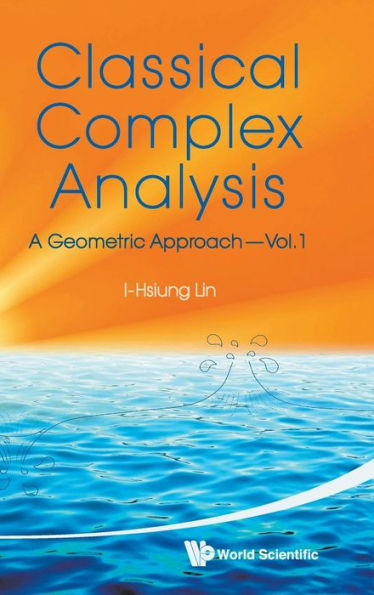Table of Contents
Preface v
Volume 1
Chapter 1 Complex Numbers 1
Sketch of the Content 1
1.1 How to Visualize Geometrically the Existence of the So-Called Complex Numbers in Our Daily Life 2
1.2 Complex Number and Its Geometric Representations 8
1.3 Complex Number System (Field) C 15
1.4 Algebraic Operations and Their Geometric Interpretations (Applications) 25
1.4.1 Conjugate complex numbers 25
1.4.2 Inequalities 30
1.4.3 Applications in (planar) Euclidean geometry 35
1.4.4 Steiner circles and symmetric points with respect to a circle (or line) 52
1.5 De Moivre Formula and nth Roots of Complex Numbers 57
1.6 Spherical Representations of Complex Numbers: Riemann Sphere and Extended Complex Plane 66
1.7 Complex Sequences 76
1.8 Elementary Point Sets 86
1.9 Completeness of the Complex Field C 97
Chapter 2 Complex-Valued Functions of a Complex Variable 104
Introduction 104
Sketch of the Content 106
2.1 Limits of Functions 107
2.2 Continuous Functions 110
2.3 Uniform Convergence of a Sequence or Series of Functions 123
2.4 Curves 129
2.5 Elementary Rational Functions 142
2.5.1 Polynomials 142
2.5.2 The power function w = zn (n ≥ 2) 148
2.5.3 Rational functions 152
2.5.4 Linear fractional (or bilinear or Möbius) transformations $$$ 157
2.5.5 Joukowski function $$$ 175
2.6 Elementary Transcendental Functions 185
2.6.1 The exponential function ez 186
2.6.2 Trigonometric functions cos z, sin z, and tan z 191
2.7 Elementary Multiple-Valued Functions 200
2.7.1 The origin of multiple-valuedness: arg z 204
2.7.2 $$$ and its Riemann surface (etc.) 214
2.7.3 w = log z (the natural logarithm function with base e) and its Riemann surface 241
2.7.4 w = cos-1 z and w = tan-1 z and their Riemann surfaces 258
2.8 Differentiation in Complex Notation 272
2.9 Integration in Complex Notation 281
Chapter 3 Fundamental Theory: Differentiation, Integration, and Analytic Functions 314
Introduction 314
Sketch of the Content 314
3.1 (Complex) Differentiation 317
3.2 Differentiability: Cauchy-Riemann Equations, their Equivalents and Meanings 325
3.2.1 (Linearly) Algebraic viewpoint 328
3.2.2 Analytic viewpoint 329
3.2.3 Geometric viewpoint 334
*3.2.4 Physical viewpoint 338
3.3 Analytic Functions 345
3.3.1 Basic examples 347
3.3.2 The analyticity of functions defined by power series 362
*3.3.3 Analyticity of multiple-valued functions and the Riemann surfaces (revisited) 372
3.4 Analytic Properties of Analytic Functions 381
3.4.1 Elementary properties derived from definition 381
3.4.2 Cauchy integral theorem and formula (simple forms): The continuity (analyticity) of the derivative of an analytic function and its Taylor series representation 387
3.4.3 The real and imaginary parts of an analytic function: Harmonic functions 435
3.4.4 The maximum-minimum principle and the open mapping property 450
3.4.5 Schwarz's lemma 464
3.4.6 The symmetry (or reflection) principle 479
*3.4.7 The inverse and implicit function theorems 493
3.5 Geometric Properties of Analytic Functions 498
3.5.1 Local behavior of an analytic function at a point: Conformality, etc. 498
3.5.2 The winding number: Its integral representation and geometric meaning 524
3.5.3 The argument principle 531
3.5.4 The Rouché's theorem 550
3.5.5 Some sufficient conditions for analytic functions to be univalent 558
*3.5.6 The inverse and implicit function theorems (revisited) 579
3.5.7 Examples of (univalently) conformal mappings 609
Chapter 4 Fundamental Theory: Integration (Advanced) 639
Introduction 639
Sketch of the Content 639
4.1 Complex Integration Independent of Paths: Primitive Functions 641
4.2 The General Form of Cauchy Integral Theorem: Homotopy 645
4.2.1 The line integral of an analytic function along a continuous curve 646
4.2.2 Homotopy of curves 651
4.2.3 Homotopic invariance of the winding numbers 655
4.2.4 Homotopic form of Cauchy integral theorem 657
4.3 The General Form of Cauchy Integral Theorem: Homology 661
4.3.1 Cycles and homology of two cycles 662
4.3.2 Simply and finitely connected domains: Homology basis 666
4.3.3 Homologous form of Cauchy integral theorem 669
4.3.4 Artin's proof 673
4.4 Characteristic Properties of Simply Connected Domains (a Review): The Single-Valuedness of a Primitive Function 678
4.5 The Branches of a Multiple-Valued Primitive Function on a Multiple-Connected Domain 683
4.6 The General Form of Cauchy Integral Formula 697
4.7 Integrals of Cauchy Type and Cauchy Principal Value 701
4.8 Taylor Series (Complicated Examples) 718
4.9 Laurent Series 733
4.9.1 The Laurent series expansion of an analytic function in a (circular) ring domain 736
4.9.2 Examples 743
4.10 Classification and Characteristic Properties of Isolated Singularities of an Analytic Function 760
4.10.1 Removable singularity 761
4.10.2 Pole 767
4.10.3 Essential singularity 785
4.11 Residues and Residue Theorem 797
4.11.1 Definition of residues 798
4.11.2 The computation of residues and examples 806
4.11.3 The residue Theorem 826
4.12 The Applications of the Residue Theorem in Evaluating the Integrals 845
4.12.1 $$$, where f(x, y) is a function in x and y, etc 846
4.12.2 $$$, etc. 858
4.12.3 Improper integrals over (-∞, ∞) 869
4.12.4 Improper integrals over (0, ∞) 910
4.12.4.1 $$$ 910
4.12.4.2 $$$ (m ε R) 921
4.12.4.3 $$$ (with periodic f(x)) 941
4.13 The Integral $$$ along a Line Re z = x0 951
4.13.1 Fourier transforms 957
4.13.2 Laplace transforms 969
4.14 Asymptotic Function and Expansion of Functions Defined by Integrals with a Parameter 994
4.15 The Summation of Series by Residues 1007
4.15.1 $$$ 1010
4.15.2 $$$ 1027
Appendix 1036
Appendix A The Real Number System R 1036
References 1039
Index of Notations 1043
Index 1049



